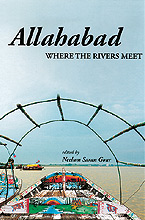I grew up in Allahabad in the ‘80s. By the time I was in my last year of school, I couldn’t wait to get out of the place and move to a bigger city, for, by the mid-90s, Allahabad was a shadow of its earlier cosmopolitan self. Country pistols and crude bombs were everywhere, Palace Theatre in the heart of town had stopped showing English movies and an air of deadness hung low over what once used to be an intellectually lively town.
Allahabad: Where the Rivers Meet (Marg Publications), edited by Neelum Saran Gour, does a thorough job of recreating the city’s past glories: the buildings dating back to Mughal and colonial times, the poets and professors who taught at its university and colleges, as well as the lawyers and judges who were the pillars of the High Court.
We meet a cast of interesting characters from Augustus S. Harrison, the first principal of Muir Central College, who rode around the city on a tricycle, to Kipling writing The Man Who Would Be King in the veranda of a gracious old villa called Belvedere House. In 1946, we find ourselves inside 14 Hastings Road, where the hall in the middle was the office of Prateek (a journal of new writing founded by Agyeya), while the four-bedroom suites around it were occupied by the editors and their families.
We shake our heads in disbelief at the horrors and defacements wrought on the domes and towers of the university by a procession of incompetent vice chancellors, one of whom had rare natural yellow and white stone painted pink and brown.
Accompanying the essays are some stunning photographs: the Moti Mahal Talkies in its full dilapidated splendour, the cycle stand of Career Coaching and the imposing All Saints Cathedral, constructed to the design of William Emerson — a design originally meant for an Australian city.




